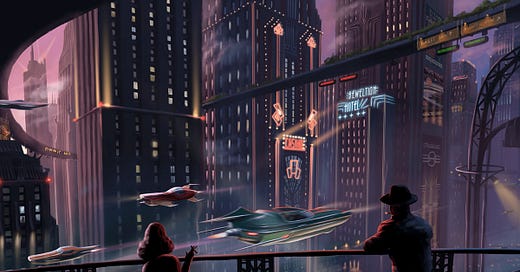The Nu-Normal #21: The Spooling Present
The limits of prophecy and failing to forecast the future.
For the last few weeks, the future has weighed on my mind. It was in the feverish search for coherent thoughts on our collective desire for futurity that I came across a quote from acclaimed sci-fi author and environmentalist Kim Stanley Robinson, taken from his 2009 novel Galileo’s Dream:
“There was nothing for it but to pace through just behind or ahead of the spooling present that was never there, caught in the nonexistent interval between the nonexistent past and the nonexistent future.”
This idea of a nonexistent future is, to me, endlessly fascinating, and I could talk for hours about the philosophical implications of that sentence. But, for our purposes here, I don’t want to dwell on stasis and empty nostalgia. Instead, I want to use it as a prompt for a fun mental exercise.
For my final column for 2022, let’s recap the issues that have risen to the top of our cultural discourse and see if we can make a non-binding forecast of where they might end up in twelve months. Now, fair warning: these prophetic visions won’t be extensively well-formed; I’m going for more of a riffing in the moment, wishcasting-through-pure-vibes-type feel, you dig? Great.
Alright, get out your crystal balls, losers—we’re doing the future.
The Downfall of NFTs and Crypto
NFTs, in their current form, are extremely stupid. The existence of marketplaces for jpeg screenshots you can (falsely) claim to own were mostly the shiny fodder of illiterate tech-bros, influencer hustlers, shameless grifters, and pyramid scheme peddlers. I think that’s been fairly obvious. (Plus, they just look bad.)
However, as someone who’s done a not-insignificant amount of crypto day trading and “line goes up” fixation, I will say that I still believe in the foundational underpinnings of cryptocurrency, that is, in the revolutionary potential of blockchain technology. Like I mentioned in Nu-Normal #12, we’ll need to ride out the next few Gartner hype cycles before we see what real innovation in this space actually looks like.
Prophetic vision: NFTs continue to become worthless while crypto winter sets in for most of 2023. People eventually forget about their losses, whales finish consolidating value, and prices begin to rise. Line goes up (again). Rinse, repeat.
The Future of Live Music
While we’ve seen the return of live music to levels approaching pre-pandemic norms, the fallout and response to a considerable lack of industry-wide support for artists have been almost existentially bleak. Artists, both big and small, are cancelling tours for various reasons, the most pronounced and consistent of which form a dichotomy of well-being: mental health and cost.
Between the Ticketmaster fiasco and venues putting the squeeze on the peripheral profit margins of independent artists—not to mention the continued dominion of big players in the streaming space—it’s hard to see how becoming a performing artist is a reasonable and achievable full-time endeavour for anyone without the benefit of obscenely viral hits and legacy money.


Prophetic vision: Calls for unionization in performing arts spaces will increase and (hopefully) gain traction alongside a push to split up industry behemoths like LiveNation Entertainment. Artists will be at the mercy of fan-driven support efforts, which will see an increase in GoFundMe campaigns and Patreon-style subscription/tip jar platforms. Streamers like Spotify, Apple Music, Amazon and others will continue to payout a fraction of their revenue in royalties. (You dogs.)
Virality, Trends, and Digital Enclaves
I was listening to an episode of the Chapo Trap House podcast this week which featured
mastermind, Ryan Broderick. The discussion centred around why far-right alternatives to social media hegemons (Facebook, Twitter, etc.) are always destined to fail in less than spectacular fashion.Broderick made the insightful observation that what draws people into these apps in the first place is the confluence of people from different areas of life: activists, journalists, celebrities, your crazy neighbour that’s addicted to posting, etc. And that without this sociological melting pot, your app lacks the special sauce to become truly viral and ubiquitous. However, this ‘public square’ approach to digitality has obvious downsides, too: namely, naked commercialisation and diminishing returns.
With his forced acquisition and haphazard management of Twitter, Elon Musk has set about destroying one of the last great (and, for many people outside the West, increasingly vital) digital ecosystems for the sake of his own ego and hubris. It’s been sad to watch (and frequently hilarious), but also far too predictable. We’ve reached a point now where these apps are so entrenched in public life and cultural discourse that their repeated abuse can have far-reaching side effects (*cough* Trump *cough*).
Capitalists want to turn everything online into their own personal pay-to-play rent-in-perpetuity fiefdom, where they alone control the bounds of discourse and get to live out their libidinal fantasies of domination and self-importance. But therein lies the rub: no one wants to pay for the privilege of keeping up to date with news and current affairs, and if everyone thinks the same and shares the same half-baked, dogshit memes… well, things get stale real quick.


Prophetic vision: Elon Musk will eventually step away from his primary role as Twitter CEO and the Internet’s main character of choice for dorky sycophants for some ‘undisclosed’ (i.e. bad for the share price) reason. He’s not a genius, and he never wanted this shit in the first place. He just wanted to be “cool” and do corny memes. In spite of his considerable stain, Twitter will persevere but remain forever changed by Musk’s reign. Late 2023 will see the beginning of the bird app usurpers poaching significant numbers of users for the digital discourse throne.
Our AI Artisan Overlords
Of all the things impacting our day-to-day lives, AI might be the most important. And you’re likely already seeing it in places you don’t care to think about: self-serve checkouts, rendered CGI backgrounds for film and television, facial recognition at airports, those annoying little chatbot assistant things that pop up on every web page, etc.
As the Internet goes, it feels like the rise of AI art has accelerated in just a few short months. I’ve joined Discord servers to use Midjourney and DALL-E 2 for creating surreal visual moodscapes. I’ve screwed around with the ChatGPT language model and tried (unsuccessfully) to get it to write hardcore lyrics. I did a trial with Soundful and created weird instrumental loops for my podcast. And just this week, I used the Tencent QQ Different Dimension Me platform to turn myself into a strikingly handsome anime side quest boss:
The point here is that this AI revolution will only continue to gain momentum, and the real question is not whether the technology becomes commonplace but rather how it gets there and who it will benefit. Human visual artists, copywriters and musicians are already lamenting the end of their respective industries. As comic book writer and Drug Church frontman Patrick Kindlon recently argued in his Do Not Siege Walled Cities newsletter:
“What's the value proposition? I believe AI art at its finest will always lack something that I value in art. But how does an artist express that in words that will resonate with their consumer? That's the challenge. And, artists, you've gotta jump on this task now. SHAME WILL NOT WORK.”
Ultimately, the power of generative AI will come down to who has the right to access and how much money they might make by profiting from it. Returning to
, Broderick lays out three different views in his recent newsletter: the Photoshop, Napster, and smartphone arguments. For my money, I agree with Brodrecik and (reluctantly) put my money on the latter.Prophetic vision: Public scrutiny will force these companies to be more transparent with their training set data, but this will also fragment generative AI away from larger monopolies and into smaller, open-source platforms with less oversight.
If you haven’t already, check out our upcoming episodes on The Pitch of Discontent podcast, where my lovely co-host and I go through our end-of-year lists and begin to round up the best records of the year.





